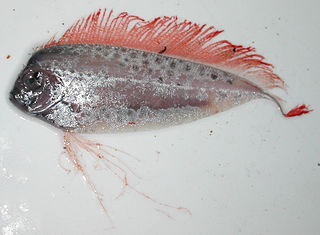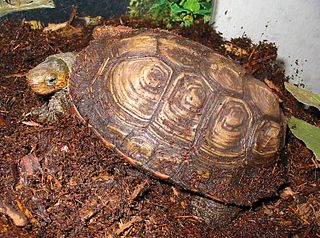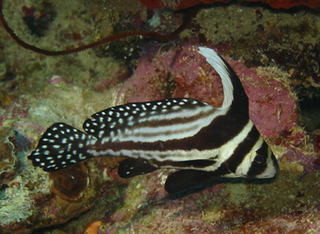
A booby is a seabird in the genus Sula, part of the family Sulidae. Boobies are closely related to the gannets (Morus), which were formerly included in Sula.

Chevrotains, or mouse-deer, are small even-toed ungulates that make up the family Tragulidae, the only extant members of the infraorder Tragulina. The 10 extant species are placed in three genera, but several species also are known only from fossils. The extant species are found in forests in South and Southeast Asia, with a single species in the rainforests of Central and West Africa. They are solitary or live in pairs, and feed almost exclusively on plant material. Chevrotains are the smallest hoofed mammals in the world. The Asian species weigh between 0.7 and 8.0 kg, while the African chevrotain is considerably larger at 7–16 kg (15–35 lb).
In biology, a monotypic taxon is a taxonomic group (taxon) that contains only one immediately subordinate taxon.

Verrucomicrobia is a phylum of bacteria that contains only a few described species. The species identified have been isolated from fresh water, marine and soil environments and human faeces. A number of as-yet uncultivated species have been identified in association with eukaryotic hosts including extrusive explosive ectosymbionts of protists and endosymbionts of nematodes residing in their gametes.

In biological classification, especially zoology, the type genus is the genus which defines a biological family and the root of the family name.

The ribbonfish are any lampriform fishes in the family Trachipteridae. These pelagic fish are named for their slim, ribbon-like appearance. They are rarely seen alive, as they typically live in deep waters, though are not bottom feeders. The perciform fish known as the red bandfish is sometimes referred to as ribbonfish, but it is unrelated to any ribbonfish in the Trachipteridae.

The giant oarfish is a species of oarfish of the family Regalecidae. It is an oceanodromous species with a worldwide distribution, excluding polar regions. Other common names include Pacific oarfish, king of herrings, ribbonfish, and streamer fish.

Acanthochelys is a genus of turtles, the spiny swamp turtles, in the family Chelidae, subfamily Chelinae, found in South America. Until recently, the species of this genus were considered to be members of the genus Platemys, but were moved to the resurrected genus originally described by Gray (1873) based on the type species by monotypy Acanthochelys spixii.

Rhinoclemmys is a genus of turtles in the family Geoemydidae, the only genus in the subfamily Rhinoclemmydinae. Member species of the genus are commonly known as the Neotropical wood turtles and are the only geoemydids known from the Americas. As such, they have adapted to a wide range of habitats, which is reflected in the species' common names.

The spotted drum or spotted ribbonfish, is a species of marine fish in the family Sciaenidae.

In biological classification, taxonomic rank is the relative level of a group of organisms in a taxonomic hierarchy. Examples of taxonomic ranks are species, genus, family, order, class, phylum, kingdom, domain, etc.
Mesodinium chamaeleon is a ciliate of the genus Mesodinium. It is known for being able to consume and maintain algae endosymbiotically for days before digesting the algae. It has the ability to eat red and green algae, and afterwards using the chlorophyll granules from the algae to generate energy, turning itself from being a heterotroph into an autotroph. The species was discovered in January 2012 outside the coast of Nivå, Denmark by professor Øjvind Moestrup.

Trachipterus is a genus of ribbonfishes.

Zu is a small genus of ribbonfishes with currently two recognized species:
Eutaeniophorus is a genus of flabby whalefish found at depths of from 10 to 200 metres in the oceans. It is monotypic, being represented by the single species, the festive ribbonfish which can grow to a length of 5.3 centimetres (2.1 in) TL.

Desmodema polystictum, also called the deal fish, polka-dot ribbonfish, or spotted ribbonfish, is a fish in the family Trachipteridae. It is found near New Zealand, the northwestern Atlantic Ocean, and South Africa. The species became more known when James Douglas Ogilby wrote and published work on the species in 1898.
Veloxidium is a genus of parasitic alveolates in the phylum Apicomplexa. Species in this genus infect marine invertebrates.

Trachipterus arcticus is a species of ribbonfish found predominantly in the North Atlantic Ocean, with one report from the Mediterranean Sea. They are rarely encountered by humans due to their deep-sea habitat and the fact that they are of no commercial value. This species is commonly referred to as the dealfish to differentiate it from the nine other ribbonfish species in the family Trachipteridae.

The Neoteleostei is a large clade of bony fish that includes the Ateleopodidae (jellynoses), Aulopiformes (lizardfish), Myctophiformes (lanternfish), Polymixiiformes (beardfish), Percopsiformes (Troutperches), Gadiformes (cods), Zeiformes (dories), Lampriformes, and the populous clade of the Acanthopterygii which includes the Beryciformes (squirrelfish) and the Percomorpha.

RV John R. Manning was an American fisheries research vessel in commission in the fleet of the United States Fish and Wildlife Service from 1950 to 1969. She explored the Pacific Ocean in search of commercially valuable populations of fish and shellfish.















